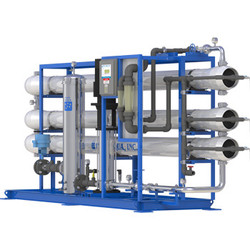Reverse Osmosis vs. Filtration
Posted by Pure Aqua, Inc. on Oct 13th 2015
Clean, clear, pure water would not be possible without the aid of some kind of a water system or process that removes contaminants and other impurities. Sure, nature has its own natural method of purifying and filtering water, but with the world’s population continuously growing and pollution on the rise from the multitude of cars on the roads and factories pumping chemicals into the air, nature’s way doesn’t always cut it. She struggles to keep up with the demands of a greedy and demanding world. Enter water systems; man made ways to duplicate nature’s natural processes and produce clean healthy water for drinking, everyday use and commercial and industrial applications.
Becoming more of a necessity than a luxury, water systems have become popular in homes, municipal water plants, beverage companies, sewage plants, hospitals, restaurants, and farms; pretty much anywhere consumable or irrigation water is needed. In a world obsessed with going green, bottled water has now become passé. The days of toting around Aquafina and Arrowhead bottles have now given way to reusable planet saving water bottles. People are finding the benefits of purifying and filtering their own home tap water a more satisfying feeling while at the same time reducing their carbon footprint. Many regional governments and water companies from water poor countries are also discovering that with the use of various water systems technology, they can filter and purify their own water and create a way for the people in their communities to have access to clean, healthy, consumable water.
Water systems come in all different flow sizes and can range anywhere from small under sink home units to large water treatment centers to giant
desalination plants. Choosing the right system for the job at hand depends on the water application and what goal is trying to be accomplished. From ground water to sea water to rain water, there is a water system for most every application.
Reverse Osmosis vs. Filtration
Not all water systems are created equal. Many use RO technology or reverse osmosis, while many others use filtration methods. Depending on what the desired outcome for the water is or what the end product is destined for, RO and filtration are the two methods that usually take care of most every water application need. Yet, while they both strive to accomplish the same goal of clean water, there are still differences between the two methods.
Reverse osmosis or RO is the scientific process by which a low concentration liquid or solvent passes through a semi-permeable membrane into a higher concentration solvent. This action generates osmotic pressure. External pressure is then applied to reverse the natural flow of the liquid, thus creating reverse osmosis. This pressure forces the liquid through the membrane where the idea is that only the water molecules in the liquid or solvent pass through leaving pure product on one side of the membrane and the left over concentrate or waste on the other. The waste drains through an exit pipe, the solvent through another to a holding tank, and the result is clean water.
Filtration is more of a natural process than a scientific one. These water systems utilize filters, which use various types of media that work to remove contaminants and various particles from the water. If we take a look at the many layers of the Earth’s crust, we will find that each layer is made up of different types of rocks, gravel and sediment. As water rains down, it passes through these different layers, each one filtering and removing some sort of contaminant. The filtered water then flows to underground wells, lakes and rivers. This is natural filtration at its best.
When we duplicate this process, we use different types of
media filters that work in the same way as the layers of the Earth. Each layer filtering and removing contaminants as the water travels through. Carbon is one of the most common media filters used. It removes odors, bad tastes, colors, and certain organics. There are many other media such as sand, gravel, silica, etc. which all do their part to remove different elements from the water.
Benefits of Both
Just because reverse osmosis and filtration are two separate processes, doesn’t mean they can’t work together to create the ultimate in purified water. From the smallest under sink unit to the larger desalination systems, paring both reverse osmosis and filtration is very common in treating unhealthy water. In fact most water systems use both methods together to gain the best results; best results for the consumer and best results for the system itself. Pre filtration of the water before it passes through a
reverse osmosis system ensures that the membranes inside the unit don’t clog with large particles and mineral buildup. This helps keep the system running longer and in top condition so that the consumer gains the best results, saving money and time in the long run.
 ENGLISH arrow_drop_down
ENGLISH arrow_drop_down
 ESPAÑOL
ESPAÑOL ???????
??????? PORTUGUÉS
PORTUGUÉS FRANÇAIS
FRANÇAIS

